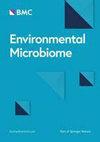Distinct changes in tomato-associated multi-kingdom microbiomes during Meloidogyne incognita parasitism
IF 6.2
2区 环境科学与生态学
Q1 GENETICS & HEREDITY
引用次数: 0
Abstract
The interplay between root-knot nematode (RKN) parasitism and the complex web of host-associated microbiota has been recognized as pivotal for effective management of the pest. However, studies assessing this relationship have focussed on the bacterial and fungal communities, neglecting the unicellular eukaryotic members. Here, we employed amplicon sequencing analysis of the bacterial 16S rRNA, fungal ITS and eukaryotic 18S rRNA genes, and comprehensively examined how the microbiome composition, diversity and networking developed with time in the rhizospheres and roots of RKN-inoculated and non-inoculated tomato plants. As expected, infection with the RKN Meloidogyne incognita decreased plant growth. At individual timepoints, we found distinct bacterial, fungal and eukaryote community structures in the RKN-inoculated and non-inoculated rhizospheres and roots, and RKN inoculation affected several taxa in the root-associated microbiome differentially. Correlation analysis revealed several bacterial and fungal and few protist taxa that correlated negatively or positively with M. incognita. Moreover, network analysis using bacterial, fungal and eukaryotic data revealed more dynamic networks with higher robustness to disturbances in the RKN-inoculated than in the non-inoculated rhizospheres/roots. Hub taxa displayed a noticeable successional pattern that coincided with different phases of M. incognita parasitism. We found that fungal hubs had strong negative correlations with bacteria and eukaryotes, while positive correlations characterized hub members within individual kingdoms. Our results reveal dynamic tomato-associated microbiomes that develop along different trajectories in plants suffering M. incognita infestation and non-infested plants. Overall, the results identify stronger associations between RKN and bacterial and fungal taxa than between eukaryotic taxa and RKN, suggesting that fungal and bacterial communities could play a larger role in the regulation of RKN. The study identifies several putative RKN-antagonistic bacterial and fungal taxa and confirms the antagonistic potential previously identified in other taxa.在黑僵菌寄生期间,与番茄相关的多界微生物群发生了不同变化
根结线虫(RKN)的寄生性与寄主相关微生物群落的复杂网络之间的相互作用已被认为是有效控制害虫的关键。然而,评估这种关系的研究主要集中在细菌和真菌群落,而忽略了单细胞真核生物成员。在这里,我们对细菌 16S rRNA、真菌 ITS 和真核生物 18S rRNA 基因进行了扩增子测序分析,并全面研究了接种 RKN 和未接种 RKN 的番茄植株根瘤和根部微生物组的组成、多样性和网络是如何随着时间的推移而发展的。正如预期的那样,感染 RKN Meloidogyne incognita 会降低植物的生长。在各个时间点上,我们发现接种 RKN 和未接种 RKN 的根瘤和根部存在不同的细菌、真菌和真核生物群落结构,接种 RKN 对根部相关微生物群中的几个类群产生了不同的影响。相关性分析表明,一些细菌和真菌类群以及少数原生动物类群与 M. incognita 存在负相关或正相关关系。此外,利用细菌、真菌和真核生物数据进行的网络分析显示,与未接种 RKN 的根瘤菌圈/根相比,接种 RKN 的根瘤菌圈/根中的网络更具活力,对干扰的稳健性更高。中枢类群显示出明显的演替模式,与 M. incognita 寄生的不同阶段相吻合。我们发现,真菌中枢与细菌和真核生物有很强的负相关关系,而在单个生物界中,中枢成员的特征则是正相关。我们的研究结果揭示了番茄相关微生物群的动态变化,这些微生物群在遭受 M. incognita 侵染的植物和未受侵染的植物中沿着不同的轨迹发展。总体而言,研究结果发现 RKN 与细菌和真菌类群之间的关联要强于真核类群与 RKN 之间的关联,这表明真菌和细菌群落可能在 RKN 的调控中发挥更大的作用。这项研究确定了几个可能与 RKN 拮抗的细菌和真菌类群,并证实了之前在其他类群中发现的拮抗潜力。
本文章由计算机程序翻译,如有差异,请以英文原文为准。
求助全文
约1分钟内获得全文
求助全文
来源期刊

Environmental Microbiome
Immunology and Microbiology-Microbiology
CiteScore
7.40
自引率
2.50%
发文量
55
审稿时长
13 weeks
期刊介绍:
Microorganisms, omnipresent across Earth's diverse environments, play a crucial role in adapting to external changes, influencing Earth's systems and cycles, and contributing significantly to agricultural practices. Through applied microbiology, they offer solutions to various everyday needs. Environmental Microbiome recognizes the universal presence and significance of microorganisms, inviting submissions that explore the diverse facets of environmental and applied microbiological research.
 求助内容:
求助内容: 应助结果提醒方式:
应助结果提醒方式:


